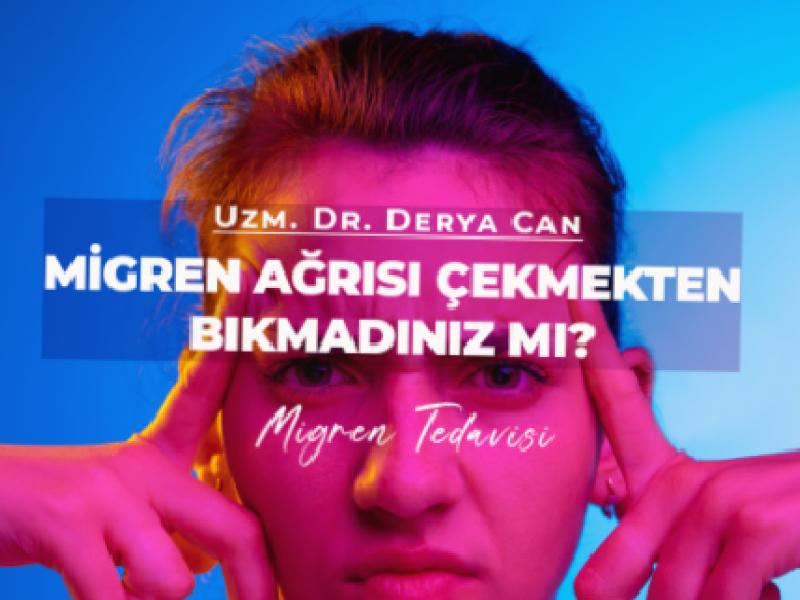WOULD YOU LIKE TO GET RELIEF FROM MIGRAINE PAINS?
Migraine is a type of headache that has serious symptoms and affects a person’s daily life. Some symptoms are also seen with the headache. The most common of these are; nausea, vomiting, difficulty speaking, numbness or tingling, sensitivity to light and sound.
Although migraine-type headache is seen in almost every age group, it is more common in women than men.
Migraine headaches are chronic and occur in attacks. There are those with and without aura. People describe what they feel during pain as follows; vibrating, throbbing, piercing, pounding and debilitating. It may also feel like a severe, dull, constant pain. The pain may begin as mild. But without treatment, it can become moderate to severe.
Migraine pain most commonly affects the forehead area. It is usually on one side of the head, but it can be on both sides or there may be a slip from one side to the other.
Most migraine attacks last about 4 hours. If they are not treated or do not respond to treatment, it can last from 72 hours to a week. In migraine with aura, the pain may begin with an aura.
Migraine symptoms may begin 1-2 days before the onset of pain. This is known as the prodrome stage. At this stage; food cravings, depression, fatigue or low energy, frequent yawning, hyperactivity, irritability, stiff neck can be seen.
In migraine with aura, the aura occurs after the prodrome phase. There may be conditions related to vision, hearing, movement and speech as aura. Some of these situations are; difficulty speaking, tingling sensations in your face, arms or legs, seeing shapes, flashes or bright spots, temporarily losing your sight.
After these stages, the painful attack period of migraine will begin. This is the most acute or severe of the phases in which true migraine pain occurs. Attack phase symptoms can last from hours to days. Migraine symptoms can vary from person to person. Migraine treatment too.
Some symptoms of migraine may include:
• Increased sensitivity to light and sound
• Nausea, vomiting
• Dizziness or feeling faint
• Pain on one side of your head, left side, right side, front or back, or temples
• Pulsating and throbbing headache
After the attack phase, the person usually has changes in mood and emotions. These can range from feeling euphoric and extremely happy to feeling very tired and apathetic. A mild, dull headache may persist.
The symptoms in these stages, their duration and intensity may differ from person to person. In some people, some of the steps may be skipped and a direct headache may begin.
What causes migraine attacks?
Conditions that often trigger migraine;
• Bright lights
• Severe heat or other weather changes
• Dehydration
• Changes in barometric pressure
• Fluctuations in estrogen and progesterone during menstruation, pregnancy or menopause, hormone changes
• Excessive stress
• Loud sounds
• Intense physical activity
• Skipping meals
• Changes in sleep patterns
• Use of certain medications such as oral contraceptives or nitroglycerin
• Fragrances
• Some foods
• To smoke
• Alcohol use
• Trip
What do we do in the treatment of migraine?
The most important issue for us in the treatment of migraine is that there is no underlying cause of the pain. If it causes migraine; Mass in the brain, cerebral hemorrhage, deterioration in blood values, etc., the underlying cause should be treated first.
However, as a result of the investigations, if a cause cannot be found in the patient and a diagnosis of migraine is made according to the symptoms and clinical condition, we take the patient to our treatment.
The most important factor in creating a treatment plan is the physical examination of the patient. Patients with this type of headache usually have myofascial pain points and trigger points in the muscles. However, this is not a common situation. Sometimes an old and chronic damage in the body can be the cause of headache. When we inject low-dose sugary serum with prolotherapy, the damage in these areas is eliminated, but it should be supported by the exercises given. With the hot-cold application and exercises recommended after the treatment, both the recovery is fast and the permanence increases. Its effect is not temporary like Botox or given medical treatments. Migraines come back when the effects of the drugs wear off.
However, after the prolotherapy treatment, the frequency of the attacks first decreases and then the pain goes away completely.
In patients with chronic and long-term migraine, treatment with PRP can be supported. In patients with rheumatic disease, prolozone therapy can be applied.
If you are tired of using painkillers and want to spend your daily life comfortably, let us treat you and step into a colorful life with us…
Is it possible to treat migraine? Is there a migraine treatment? Migraine attacks. Chronic Migraine. Migraine stages. What is good for migraine? Migraine symptoms.

